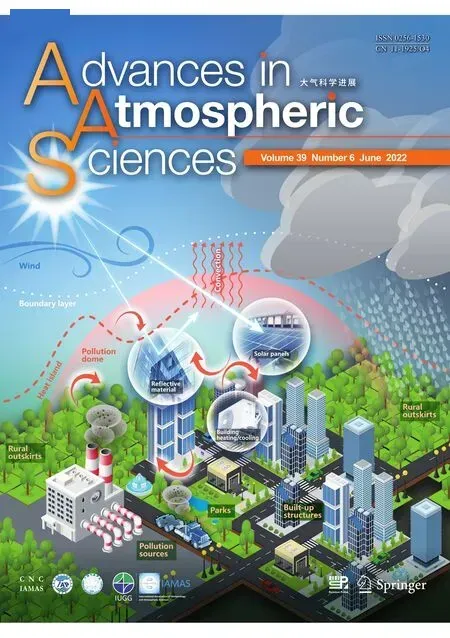Structure and Evolution of Decadal Spiciness Variability in the North Pacific during 2004-20, Revealed from Argo Observations
2022-04-02GuanghuiZHOUandRongHuaZHANG
Guanghui ZHOU and Rong-Hua ZHANG*,3,4
1CAS Key Laboratory of Ocean Circulation and Waves, Institute of Oceanology, and Center for Ocean Mega-Science,Chinese Academy of Sciences, Qingdao 266071, China
2University of Chinese Academy of Sciences, Beijing 100029, China
3Laboratory for Ocean and Climate Dynamics, Pilot National Laboratory for Marine Science and Technology,Qingdao 266237, China
4Center for Excellence in Quaternary Science and Global Change, Chinese Academy of Sciences, Xi’an 710061, China
ABSTRACT Ocean spiciness is referred to as density-compensated temperature and salinity variations with warm (cool) and salty(fresh) waters having high (low) spiciness, respectively. The structure and evolution of density-compensated (warm/salty or cool/fresh) spiciness anomalies are investigated in the North Pacific thermocline using Argo observations during the period 2004-20. Two well-organized decadal spiciness events are identified through isopycnal surface analyses. One warm/salty spiciness anomaly of about 0.15°C and 0.05 g kg-1 temperature and salinity perturbations on the 25 kg m-3 isopycnal surface appeared in the eastern subtropical North Pacific at (18°-30°N, 120°-150°W) in 2007, which then migrated southwestward along the mean circulation and arrived in the western tropics at (~15°N, 145°E-175°W) in 2012-13, with the reduced salinity perturbation of about 0.043 g kg-1. Another cool/fresh spiciness anomaly of about -0.2°C and-0.07 g kg-1 temperature and salinity perturbations originated from the eastern subtropics at (120°-150°W, ~30°N) in 2014 and followed a similar advective pathway during the period from 2014-15 to 2019-20. The subduction pathway can be adequately determined by the mean Montgomery stream function on the isopycnal surface; the propagation direction and speed are in good agreement with the expectation for the role played by advection due to the mean geostrophic current.Moreover, the subducted decadal spiciness anomalies can have negative feedback on sea surface temperature (SST)variability in the western tropical Pacific through the diapycnal processes. The identifications of these density-compensated spiciness anomalies and their propagation pathways provide a clear illustration of the oceanic extratropics-tropics interactions in the North Pacific Ocean.
Key words: isopycnal analysis, spiciness anomalies, subduction pathway, advection role, decadal variability, North Pacific
1. Introduction
Ocean-atmosphere interactions induce a broad spectrum of climate variabilities. Over the Pacific basin, the El Niño-Southern Oscillation (ENSO) phenomenon is the most prominent interannual variability having a period of two to seven years in the tropical Pacific (Philander, 1999;Fedorov and Philander, 2000; Gao et al., 2020). The Pacific Decadal Oscillation (PDO) has its dominant appearance in the extratropical North Pacific. The interactions between interannual and decadal variabilities in the extratropics and tropics over the Pacific basin occur both in the atmosphere and ocean (Gu and Philander, 1997; Zhang et al., 1998), which are named the atmospheric bridge and oceanic bridge, respectively.
In the atmosphere, many studies on ENSO dynamics and effects indicate that the tropical SST can affect the extratropical atmosphere, a process termed teleconnection(Alexander et al., 2002; Vimont et al., 2009). In terms of the extratropics-to-tropics effects, the Pacific Meridional Mode(PMM) provides a conduit through which the extratropical atmosphere can affect ENSO, which is centered in the tropical Pacific (Chang et al., 2007). The PMM is also reflected as the Seasonal Footprint Mechanism (SFM), in which the tropical atmospheric anomalies during the spring and summer are seasonally forced by Sea Surface Temperature(SST) anomalies generated by mid-latitude atmospheric variability during the previous winter (Chang et al., 2007;Vimont et al., 2009).
In the ocean, the extratropics and tropics are connected through the Pacific subtropical cells (STCs), a shallow meridional overturning circulation in the upper ocean (Rothstein et al., 1998; McPhaden and Zhang, 2002; Lee and Fukumori,2003; Chen et al., 2015). The STCs, primarily driven by surface wind, are composed of the surface subtropical gyre circulations and the thermocline ventilation processes. For example, in the surface layer, the western boundary currents (WBCs) transport heat and water mass from the tropics to the extratropics (Zhang and Levitus, 1997; Zhang et al., 1998; Du et al., 2019; Zeller et al., 2021). In contrast,through the thermocline ventilation processes, water masses are subducted in the subtropical outcrop regions and advected southwestward along the isopycnal surfaces (Zhang and Liu; 1999; Huang and Wang, 2001; Zeller et al., 2021).When they arrive in the western Pacific, most of the water masses are obducted and recirculate around the subtropical region through the poleward WBCs (e.g., Kuroshio). At the same time, through the equatorward low-latitude WBCs(e.g., Mindanao Current or New Guinea Coastal Current) or the interior pathway (the interior communication window;Huang and Wang, 2001; Zeller et al., 2021), the rest of the water masses feed into the equatorial undercurrent, resurface in the eastern equatorial Pacific, and eventually recycle to the subtropics, thus forming a complete loop of the STCs(Gu and Philander, 1997; Rothstein et al., 1998; Deser et al.,2004). Thus, the STCs are critically important to mass, heat,and salt redistributions between the extratropical and tropical oceans. Abundant observational analyses have been performed to provide more evidence for the role played by the STCs in climate variability and predictability in the Pacific(Zhang et al., 1998; Zhang and Liu, 1999; Luo and Yamagata, 2001).
Based on the dominant processes involved in climate variability, two types of thermohaline anomalies have been identified in the Pacific. One is associated with thermocline fluctuations that can significantly affect oceanic density (Tailleux et al., 2005; Kang et al., 2014; Gao et al., 2020; Li et al.,2020); their properties are mainly determined by planetary wave dynamics (the first mode of westward propagating baroclinic Rossby waves), with signals being mostly prominent in the surface layer due to diabatic wind forcing processes(as clearly seen in sea surface height anomalies). The other is associated with density-compensated temperature and salinity variations, known as spiciness in the ocean (Veronis,1972; Munk, 1981; Stipa, 2002; Huang, 2011; McDougall and Krzysik, 2015; Huang et al., 2018). Phenomenally,thermal and salt perturbations of water masses can be density-compensated by each other with their evolutions being like a passive tracer; these thermal and/or salt perturbations are referred to as anomalies of ocean spiciness, a variable that is introduced to represent how warm and salty (spicy)are waters of a given density. Previous studies have demonstrated that spiciness anomalies in the thermocline are advected by the mean flow on isopycnal surfaces (Luo et al.,2005; Sasaki et al., 2010; Kolodziejczyk and Gaillard, 2012;Li et al., 2013), thus acting as a passive tracer that can retain climate signals in the ocean for a long time (Qu et al., 2009;Kawakami et al., 2020). For example, spiciness anomalies subducted in the North Pacific extratropical region are advected on the isopycnal surface around 25 kg m-3and arrive in the tropics in about 5 years; those in the South Pacific take about 2 years (Schneider, 2000, 2004; Sasaki et al., 2010;Kolodziejczyk and Gaillard, 2012; Zhang and Qu, 2014;Zeller et al., 2021). Therefore, the advection of spiciness anomalies can influence tropical variabilities on interannual-to-decadal scales. Consequently, the asymmetric effects and relative dominances of the extratropical anomalies in the North and South Pacific may be related to the differences in ENSO properties (Luo and Yamagata, 2001;Kuntz and Schrag, 2018; Qi et al., 2019). For example,Zeller et al. (2021) use an ocean general circulation model(OGCM) to quantify the origins of the subsurface tropical waters in the Pacific Ocean. It turns out that 75% of water masses in the tropics are from the subtropics, with twothirds coming from the Southern Hemisphere. Correspondingly, warm spiciness anomalies are advected from the Southern Hemisphere (65%), while cold spiciness anomalies are advected from the Northern Hemisphere (48%).
Because of the sparcity of salinity observations, most previous studies have been focused on the origin, propagation,advection, and effects of subducted thermal anomalies in the Pacific Ocean (Zhang et al., 1998; Zhang and Liu, 1999;Schneider et al., 2000; Luo and Yamagata, 2001). With the advent of the Argo drifting buoys network, basin-wide salinity data became available. Coherent temperature and salinity data have been collectively used to study the advection of spiciness anomalies, instead of just thermal anomalies alone (Yeager and Large, 2007; Sasaki et al., 2010;Kolodziejczyk and Gaillard, 2012; Li et al., 2013; Zhang and Qu, 2014; Thomas and Fedorov, 2017). For example, spiciness variability has been the focus in some studies using temperature and salinity observations on interannual time scales. In particular, Sasaki et al. (2010) analyzed decadal spiciness anomalies using 9-year observations during 2001-08.Due to the short observational data used, however, a detailed description of a full cycle of decadal spiciness variability was still lacking, including spatial patterns and basinwide transitions from one decadal phase to its opposite phase. As a result, the persistence and transformation of spiciness anomalies produced in the subduction regions to the tropical oceans have not been well understood both observationally and theoretically. Furthermore, the interplays between the ocean-atmosphere processes in the Pacific basin, such as associations with ENSO in the tropics and PDO in the extratropics, are potentially affected by the advected spiciness anomalies. So, it is necessary to have a coherent picture of decadal spiciness variability in the North Pacific to shed light on density-compensated spiciness anomalies and the related processes and mechanisms (Rudnick and Ferrari,1999; Tailleux et al., 2005).
Because the generation and advection of spiciness anomalies on isopycnal surfaces mostly exhibit decadal-to-interdecadal time scales (Kilpatrick et al., 2011), it is highly desirable to use long-term observations to have a better understanding of the space-time evolution of spiciness anomalies and their possible influences on the interactions between the extratropical and tropical oceans. In this study, we thus investigate the decadal advective spiciness anomalies on the 25 kg m-3isopycnal surface in the North Pacific using 17-year Argo gridded data during the periods 2004-20. For the first time, a full cycle of spiciness variability was discovered from observations on the decadal time scale in the North Pacific. Furthermore, we use mean geostrophic velocity fields and mean stream function on the isopycnal surface to trace the pathway and trajectory of the yearly spiciness anomalies. Two well-defined decadal spiciness events are detected through isopycnal surface analyses. The preliminary results suggest that the adiabatic advection processes play a dominant role in determining the structure and evolution properties of the decadal spiciness variability. Through these analyses, we hope to shed light on the formation, advection, and fate of spiciness decadal anomalies in the North Pacific; the identified pathway provides observational evidence for the extratropical-tropical exchanges, which contributes to decadal climate variability in the Pacific Ocean-atmosphere coupled system.
The rest of this paper is organized as follows. Section 2 introduces the data and analysis methods. Section 3 illustrates the patterns of the related mean states in the North Pacific, followed by section 4 describing the characteristics of spiciness anomalies which are identified on the isopycnal surface (25 kg m-3). The decadal pathway and the advection roles are illuminated in section 5, including space-time propagation of spiciness anomalies on the isopycnal surface (25 kg m-3). In the end, we summarize the synthesis results and discuss the implications.
2. Data and Methods
2.1. The Argo Data
The gridded Argo data provided by Roemmich and Gilson (2009, RG Argo) were used to investigate the characteristics of decadal spiciness anomalies, including structure and advection properties on the isopycnal surface (25 kg m-3)in the North Pacific. The RG Argo data are mapped for monthly temperature and salinity fields, using a weighted least squares fit to the Argo profiles during the periods of 2004-20 (Roemmich and Gilson, 2009). The horizontal resolution is 1° × 1° and the vertical resolution is O (10 m) in the upper 170 dbar (1 dbar = 104Pa) and becomes coarser below when extending depths to 1975 dbar.
2.2. The isopycnal surface analysis
First, we derived the potential temperature and absolute salinity fields (McDougall and Klocker, 2010) using the 17-year monthly three-dimensional temperature and salinity data. Then, the potential density, the Mixed Layer Depth(MLD), the Potential Vorticity (PV), the Montgomery Stream Function (MSF), and the Geostrophic velocity (GV)fields in the depth coordinate (z-coordinate) system were diagnosed following the methods described by McDougall and Klocker (2010) (using GSW V2.0 library). Subsequently,we estimated the depth and thickness of isopycnal surfaces.Finally, we interpolated the potential temperature, absolute salinity, potential density, PV, MSF, and GV fields into the isopycnal-coordinate system from the depth-coordinate system. At the same time, we calculated the corresponding climatological oceanic means of both observed and diagnosed fields during the 17-year periods.
In our study, the MLD was estimated using a density criterion with a temperature difference of 0.2°C. We adopted the same technique suggested by de Boyer Montégut et al.(2007). Specifically, the MLD is determined for each vertical profile as the critical depth where density changes (Δρ)are greater than those at 10 m depth [min(H(Δρmld>Δρ10m)),where H represents vertical depth] when the temperature changes ΔT=0.2°C and the density changes Δρ=-(∂ρ /∂T)ΔT, equivalently. The PV is defined as Q=ρ0-1f∂σθ/∂z, in which f is the Coriolis parameter.
The geostrophic stream function, Ψ, relative to the reference pressure (P=Pref,units: dbar) is given by i nduced by absolute salinity anomaly. Θ[P′] is the pressure

P′ is the pressure anomaly, SA[ P′] is the pressure anomaly anomaly induced by potential temperature anomaly. SAand Θ are absolute salinity and potential temperature, and both are the function of P.is the specific-volume anomaly defined as


where SAandwith reference values:andare taken to be 35.165 g kg-1and 0°C, respectively.
We calculated the GV at pressure P versus the reference (P=Pref,units: dbar). The formulas for the GV are expressed as follows

where f is the Coriolis parameter and Ψ is the geostrophic stream function in a particular pressure. Thus, the horizontal geostrophic velocity v at P pressure surface is simply related to the two-dimensional gradients of Ψ on the same surface and the reference velocity vrefat Prefpressure surface.
The MSF (Montgomery, 1937; and Cushman, 1994),ΨM, is defined by

which is the acceleration potential for the flow on the specific-volume anomaly surface, with respect to the flow at Prefdbar. The Montgomery streamfunction and the geostrophic velocities on isopycnal surfaces were calculated from the gridded hydrography data using the bottom level as the reference.
Considering that spiciness anomalies are mostly prominent in the thermocline layers, we chose the 25 kg m-3isopycnal surface as the main interest of our analysis. The spiciness anomalies on the isopycnal surface (25 kg m-3) reflect major signals of thermocline variabilities in the North Pacific subsurface ocean (Katsura, 2018). The spiciness anomaly generation and advection characteristics on the 25 kg m-3isopycnal surface are analyzed to support the hypothesis that decadal thermocline variability originated from the mid-latitude region has a decade-long memory in the subsurface ocean, which can influence ocean conditions in the tropics.
3. Mean State
Here, the mean-state structure and properties are documented for the 25 kg m-3isopycnal surface within the ventilated thermocline. The long-term mean depth of the 25 kg m-3isopycnal surface (Fig. 1a) has a bowl-shaped structure around the subtropical gyre connecting the extratropical and tropical Pacific (Kawakami et al., 2020). The winter outcrop line on the 25 kg m-3isopycnal surface is situated meridionally between 30°N and 35°N and zonally from 140°E to 160°W; it then sharply turns northeastward to the east of 160°W (the magenta line in Fig. 1a) in the North Pacific.The white contours in Figs. 1a-d denote the 20.8 and 22.7 m2s-2isopleths of the long-term mean MSF calculated on the 25 kg m-3isopycnal surface, which is basically around the subtropical gyre. The water subducted to the east of 160°W is advected southwestward along with the MSF(the white contours in Fig. 1a) between 120°W and 150°W,and then westward to the low-latitude western boundary in the North Equatorial Current (NEC) region between 9°N and 15°N. In this study, we mainly focus on the spiciness anomalies advected along the subduction pathway in the North Pacific (the white dots in Fig. 1a).
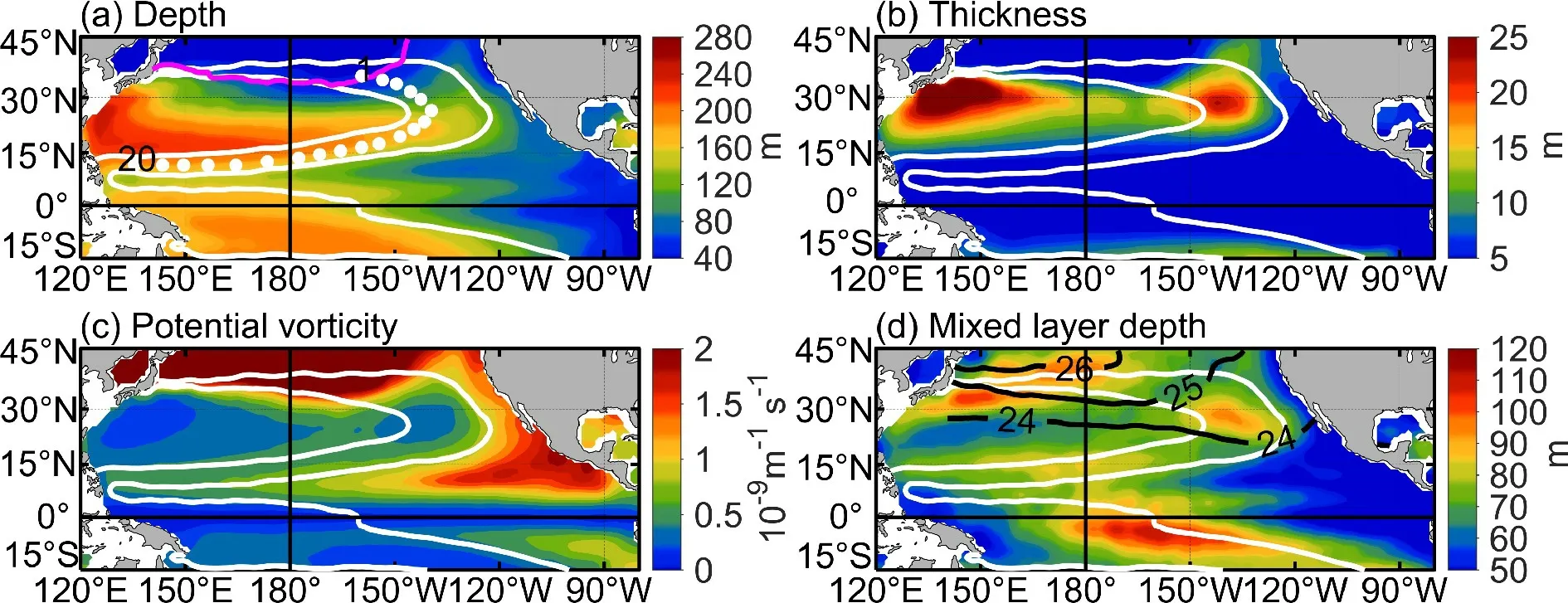
Fig. 1. The Argo derived long-term mean fields of (a) depth, (b) thickness, (c) potential vorticity on the 25 kg m-3 isopycnal surface, and (d) the mixed layer depth, which are averaged during the periods 2004-20. The white contours in (a-d) denote the 20.8 and 22.7 m2 s-2 isopleths of the mean Montgomery stream function calculated on the 25 kg m-3 isopycnal surface.The σθ= 25 kg m-3 surface outcrops along the magenta line in February in (a). Potential vorticity in (c) is defined as ρ-01f (∂σθ/∂z), in which f is the Coriolis parameter. The black contours in (d) denote the isopleths of σθ= 24, 25, and 26 kg m-3 at the base of the mixed layer. The mixed layer depths are estimated using a density criterion with a temperature difference of 0.2°C (de Boyer Montégut et al., 2007). The contour intervals are m in (a), (b) and (d), and 10-9 m-1 s-1 in (c).
The thickness of the 25 kg m-3isopycnal surface (Fig.1b) has two large centers located around 30°N in the North Pacific at about 140°E and 140°W, respectively. These two low PV areas correspond to the subtropical mode water(STMW) and the eastern subtropical mode water(ESTMW), respectively (Fig. 1c). The STMW formation favors the generation of spiciness anomalies, and the related PV on the 25 kg m-3isopycnal surface (Fig. 1c) is roughly conserved along the advection pathway except for near the outcrop region (Schneider, 2004; Qu et al., 2009; Katsura,2018). These conserved PV fields constrain the advection pathway of the spiciness anomalies with the density-compensated features being well maintained. The MLDs are also large in the subduction regions and the STMW origin regions (Fig. 1d; the black contours denote the isopleths of σθ= 24, 25, and 26 kg m-3at the base of the mixed layer).The 25 kg m-3isopleth at the mixed-layer base is located close to the STMW origin regions, so, this surface is a reasonable choice for observation-based analyses, clearly representing the generation and advection of thermocline anomalies from the subtropical to the tropical ocean in the Pacific(Zhang et al., 1999; Zhang and Liu 1999; Sasaki et al., 2010).
Figures 2a-b depict the long-term mean temperature and salinity fields on the 25 kg m-3isopycnal surface. Large horizontal spiciness gradients along the isopleths of the mean MSF are seen in the northeastern subtropical Pacific.The standard deviations of temperature and salinity perturbations on the 25 kg m-3isopycnal surface (Figs. 2c-d) show the spatial structure of the variabilities. The greatest variability can be seen around the edge of the subtropical gyre,which reflects the subduction signature of spiciness anomalies from the surface into the thermocline in the mid-latitude outcrop region; these anomaly signals are then advected by the subtropical gyre on the 25 kg m-3isopycnal surface. A gyre-scale band with large spiciness variability is seen to circulate around the subtropical gyre from the mid-latitudes to the western tropics in the North Pacific.
There are two main regions with low spiciness variability. One is located in the Pacific western subtropics in 10°-30°N; this appears to reflect the unventilated thermocline nearly in the center of the subtropical gyre (Zhang and Liu, 1999). Another band lies in the northeastern tropical Pacific in 0°-15°N; this may reflect the signature of the unventilated thermocline associated with the shadow zone in the eastern part of the subtropical gyre (Zhang and Liu,1999).
The long-term mean GV and depth on the 25 kg m-3isopycnal surface were derived from Argo observations during the periods 2004-20 (Fig. 3). The 3D-view spatial pattern of the GV consists of the depth gradients on the 25 kg m-3isopycnal surface. Clearly, the 3D-view depth shows more details on the isopycnal surface, providing a better visual perception of the related dynamic processes on the isopycnal surface. For example, the spiciness anomaly advection on the isopycnal surface can be explained via the related GV and depth fields (Fig. 3).
4. A decadal cycle of spiciness variability
In this section, annual-mean temperature and salinity perturbations are estimated on the 25 kg m-3isopycnal surface using the Argo products. These perturbations represent deviations from the corresponding mean-field computed during the periods 2004-20. Two spiciness advection events are detected through the isopycnal surface analyses, as demonstrated in Figs. 4 and 5, respectively.
4.1. The warm/salty spiciness advection event
One warm/salty spiciness anomaly is seen to originate in the subtropical North Pacific at (18°-30°N, 120°-150°W)in 2007 (Figs. 4a-b), and then is advected clockwise around the subtropical gyre from 2007 to 2013 (the yellow contours in Fig. 4 indicate the 0.15°C and 0.05 g kg-1temperature and salinity isopleths). Following that, the spiciness anomaly migrates southwestward along with the mean MSF, and subsequently is enhanced when passing by Hawaii around 2009-10, but when it approaches the western boundary at 10°N around 2012-13, it dampens in the western tropical Pacific to the west of the dateline (Figs. 4k-n). These changes in the amplitude of spiciness anomalies can be attributed to several factors, including local wind and freshwater forcing, the surrounding marine environments (thermal and salt conditions), and fluctuations in the isopycnal surfaces(Lukas, 2001; Lukas and Santiago-Mandujano, 2008).
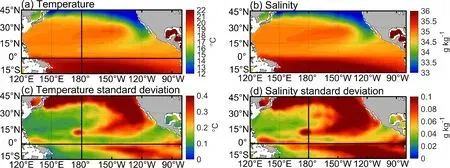
Fig. 2. The Argo derived long-term mean fields of (a) temperature and (b) salinity, which are averaged during the periods 2004-20; (c) temperature standard deviation and (d) salinity standard deviation on the 25 kg m-3 isopycnal surface. The contour intervals are °C in (a, c) and g kg-1 in (b, d).
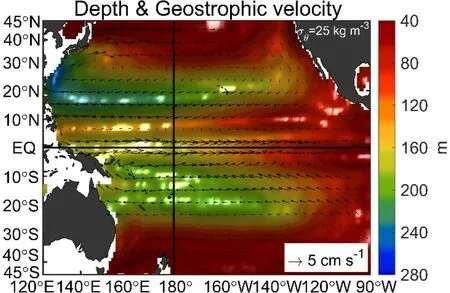
Fig. 3. The Argo derived long-term mean depth and geostrophic velocity on the 25 kg m-3 isopycnal surface, which are averaged during the periods 2004-20.
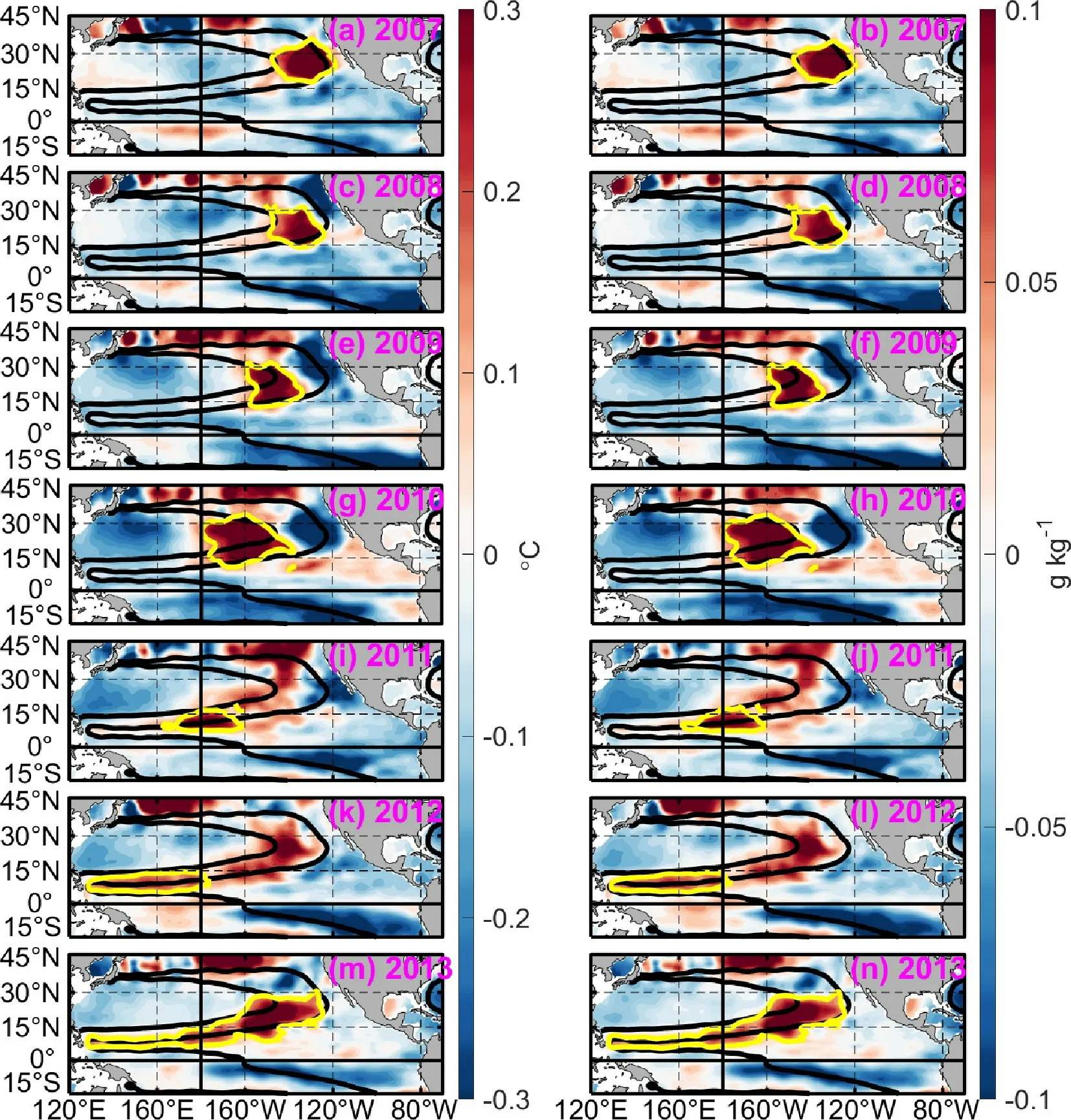
Fig. 4. Annual-mean temperature (the left panels) and salinity (the right panels) anomalies estimated on the 25 kg m-3 isopycnal from 2007 to 2013 based on the Argo products. The anomalies are deviations from the corresponding mean-field computed during the periods 2004-20. The yellow contours indicate the 0.15°C and 0.05 g kg-1 isopleths of (left) annual mean temperature and (right) salinity anomalies, respectively. The black contours denote the 20.8 and 22.7 m2 s-2 mean Montgomery streamfunction isopleths. The contour intervals are 0.1°C (the left panels) and 0.05 g kg-1 (the right panels).
Also, a cold/fresh spiciness anomaly emerges in the northeastern subtropical Pacific, whose polarity is opposite to the previous warm/salty anomaly during 2008-11 (Figs.4c-j). Finally, the opposite (cold/fresh) spiciness anomalies are arrested and damped by the PV ridge in the shadow zone around 15°N in the eastern tropical Pacific.
It is interesting to note that when the warm/salty spiciness anomalies arrived in the western tropics in 2010-11,two successive La Niña events coincidently occurred in the tropical Pacific in 2010 and 2011-12, respectively. The arrived warm/salty spiciness anomalies could deepen the local MLD (Fig. 8a) and the thermocline (Fig. 8b) in the western tropical Pacific, accompanied with negative SSTA (Fig.9a) and positive SSSA (Fig. 9b). These changes are in favor of La Niña's conditions. The relationships between the spiciness variability and the ENSO modulations need further investigation (Zheng and Zhang, 2012, 2015; Zhu et al.,2014; Zhi et al., 2019b), which is beyond the scope of this paper.
4.2. The cold/fresh spiciness advection event
Another cold/fresh spiciness anomaly emerged in 2014 in the northeastern subtropical region and then propagated southwestward around the subtropical gyre on the 25 kg m-3isopycnal surface from 2014 to 2020 (Fig. 5; the green contours indicating the -0.2°C and -0.07 g kg-1temperature and salinity isopleths). These anomalies were first detected at about 30°N in the eastern subtropical Pacific in 2014(Figs. 5a-b) and then migrated southwestward along with the mean MSF, reaching the western boundary at 10°N around 2019-20 (Figs. 5k-n). The spiciness anomaly was then amplified when passing by Hawaii around 2015-16,but attenuated during 2019-20 in the western tropics at about 10°N west of the dateline. At the same time, an opposite (warm/salty) spiciness anomaly was generated in the northeastern subtropical Pacific during 2014-20 (Figs. 5a-n).Finally, the opposite (warm/salty) spiciness anomalies were blocked by the PV ridge in the shadow zone around the eastern tropical Pacific at 15°N, coherently following the warm/salty spiciness anomalies during 2016-20.
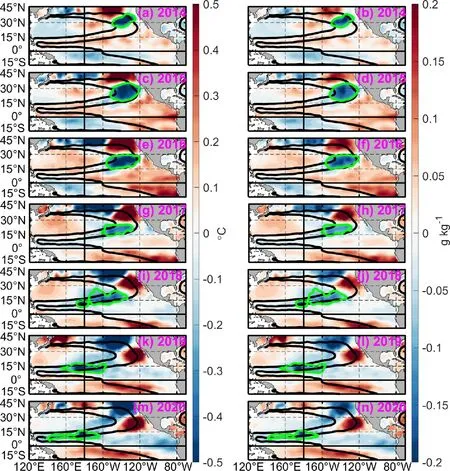
Fig. 5. Annual mean temperature (the left panels) and salinity (the right panels) anomalies averaged on the 25 kg m-3 (right) from 2014 to 2020 based on the Argo products; the anomalies are deviations from the corresponding mean-field computed during the periods 2004-20. The black contours denote the 20.8 and 22.7 m2 s-2 mean Montgomery stream function isopleths. The green contours indicate -0.2°C and -0.07 g kg-1 isopleths of (left) annual mean temperature and (right) salinity anomalies, respectively. The contour intervals are 0.1°C (the left panels) and 0.05 g kg-1 (the right panels).
The PV ridge is caused by the thermocline depth distribution pattern; this ridge is located at 5°-15°N in the northeastern tropical Pacific where PV is a maximum. Coincidently,the inter-tropical convergence zone (ITCZ) is located above this area in association with a well-defined pattern of wind stress curl. The PV ridge bends the geostrophic current as it crosses the large PV gradient into a zonal direction so that the extratropical water can’t directly exchange with the tropical water through this area. So a large part of the warm/salty spiciness anomalies must propagate zonally westward at around 15°N, and a small part of those overshoot the PV ridge through the interior communication window to the west near the dateline.
5. The space-time evolution of decadal spiciness anomalies and effects
The newly available Argo data provide us with a unique opportunity to make a more comprehensive analysis of the structure and evolution of decadal spiciness variability over a relatively long-time period. In particular, the two identified decadal events consist of a full cycle of spiciness variability, characterized by a warm/salty phase during 2007-13 and a cold/fresh phase during 2014-20, respectively. From a dynamical point of view, the spiciness gradients are large along isopleths of the mean MSF on the 25 kg m-3isopycnal surface in the eastern subtropics (the colors in Fig. 6). Moreover, the vertical salinity gradient indicates unstable stratification in the upper ocean (Yeager and Large, 2007). In terms of water mass formulation, Johnson(2006) illustrated that the Eastern North Pacific Subtropical Mode Water (ENPSMW) can be formed at the base of the deep mixed layer where the density is close to 25 kg m-3(Fig. 1d). These conditions favor the spiciness anomaly generation in the subduction pathway upstream region through three processes: anomalous advection across salinity/temperature gradients (Schneider, 2000, 2004), diapycnal mixing underneath the mixed layer (Johnson, 2006; Yeager and Large, 2007), and the surface fluxes incorporated into the mixed layer, respectively. After their generation, spiciness anomalies tend to propagate around the subtropical gyres.The corresponding anomaly propagation and advection from the subtropics to the tropics in the North Pacific indicate the subduction pathway around the subtropical gyre.These are further analyzed in this section.
5.1. The subduction pathway
In Figs. 6a-b, yearly warm and salty spiciness anomalies on the 25 kg m-3isopycnal surface are overlapped with the isopleths of the mean MSF during the periods 2007-12 (the white contours in Fig. 6). The colored contours denote 0.15°C and 0.05 g kg-1temperature and salinity isopleths, which are used to trace the yearly temperature(Fig. 6a) and salinity (Fig. 6b) perturbations in 2007(black), 2008 (red), 2009 (yellow), 2010 (cyan), 2011(green), and 2012 (blue), respectively. Figures 6c-d are for the corresponding cool and fresh spiciness anomalies on the 25 kg m-3isopycnal surface during the periods 2014-20.The colored contours denote -0.2°C and -0.07 g kg-1temperature and salinity isopleths, indicating the trajectories of yearly temperature (Fig. 6c) and salinity (Fig. 6d) perturbations in 2014 (black), 2015 (red), 2016 (yellow), 2017(cyan), 2018 (green), 2019 (blue) and 2020 (black), respectively. These plots are based on the interpolated Argo product, with additional spatial smoothing applied to improve the visualization. The background fields indicate the long-term mean of temperature and salinity fields during the periods 2004-20, which are averaged on the same isopycnal surface.
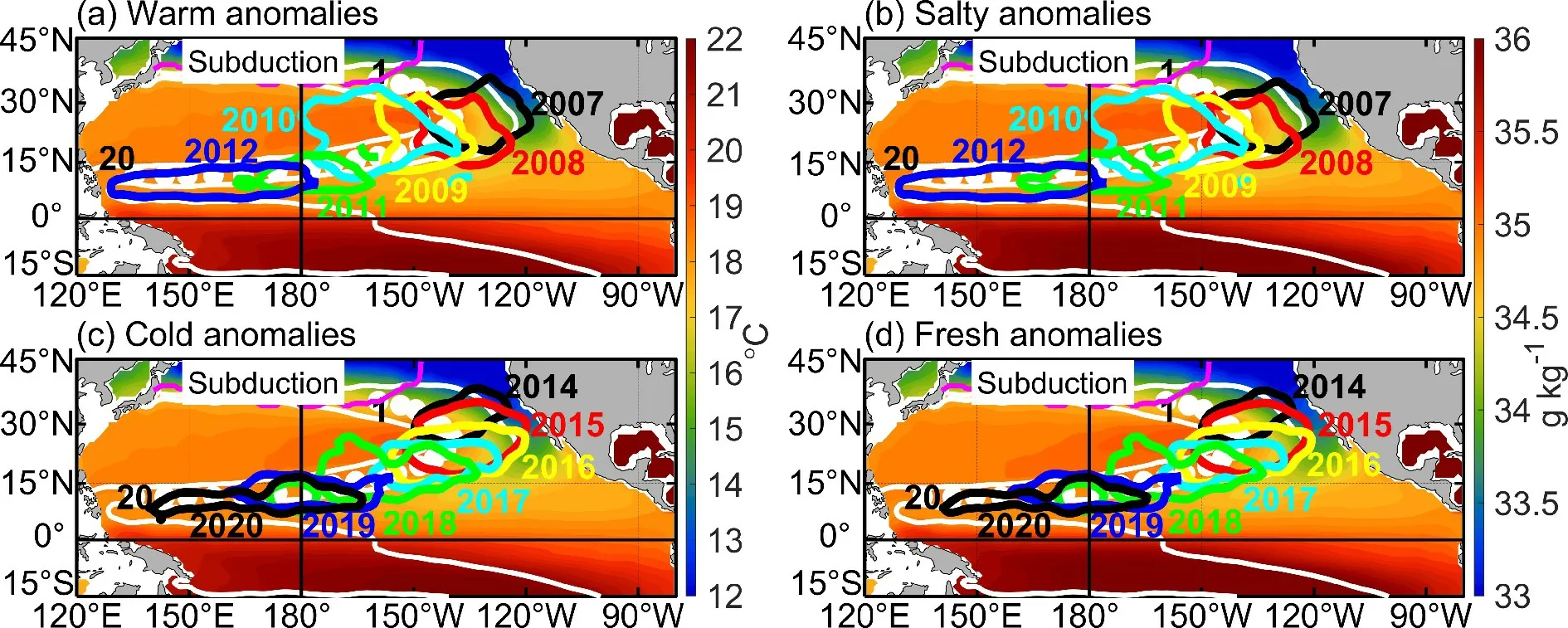
Fig. 6. Warm (a) and salty (b) spiciness anomalies on the 25 kg m-3 isopycnal surface, overlapped on the isopleths of the mean Montgomery stream function (the white contours) during the periods 2007-12. The colored contours denote 0.15 °C and 0.05 g kg-1 isopleths for yearly temperature (a) and salinity (b) anomalies in 2007 (black), 2008 (red), 2009 (yellow),2010 (cyan), 2011 (green), and 2012 (blue), respectively. The corresponding cold (c) and fresh (d) spiciness anomalies on the 25 kg m-3 isopycnal surface during the periods 2014-20. The colored contours denote -0.2°C and -0.07 g kg-1 isopleths of yearly temperature (c) and salinity (d) anomalies in 2014 (black), 2015 (red), 2016 (yellow), 2017 (cyan), 2018 (green),2019 (blue) and 2020 (black), respectively. These plots are based on the interpolated Argo product, with additional spatial smoothing applied to improve the visualization. The background fields plotted in these figures indicate the long-term mean of temperature and salinity fields averaged on the same isopycnal from the Argo observations during the periods 2004-20.The σθ = 25 kg m-3 surface outcrops along the magenta line in February. The white dots plotted in the figure indicate the subduction mean path (represented by stream function) starting from the outcrop line in the North Pacific.
Through the hind-cast trajectory estimation, the subduction pathway is specifically displayed by the white dots plotted in Fig. 6 (represented by the mean stream function),which starts from the outcrop region in the subtropics to the tropical western boundary in the North Pacific. This pattern is coherently consistent with the mean MSF around the 20.8-22.7 m2s-2contours and the advection trajectories of the yearly spiciness anomalies. It is seen that decadal spiciness signals coherently and persistently are generated in the subduction region on decadal time scales, which are then advected from the subduction region to the western tropical Pacific.
5.2. The decadal anomaly advection along the subduction pathway
The variations in temperature and salinity along the subduction pathway on the 25 kg m-3isopycnal surface are illustrated in this subsection by averaging the corresponding spiciness anomalies between the 20.8 and 22.7 m2s-2isopleths of the mean MSF, as have been investigated by earlier studies (e.g., Sasaki et al., 2010; Li et al., 2013). The temperature (Fig. 7a) and salinity (Fig. 7b) perturbations are coherently advected along the subduction pathway, with their nearly compensated effects on density at decade time scales.As confirmed in Fig. 7, the warm/salty or cool/fresh spiciness anomalies are seen to be advected primarily by the mean geostrophic currents. The mean GV is consistent with the spiciness signal advection along the subtropical gyre. As seen, the warm/salty spiciness anomalies propagate from the subduction region to the western boundary of the tropical North Pacific during 2004-14, and so do the cold/fresh spiciness anomalies during 2014-20. The slope of the white dashed lines in the Hövmuller diagram (Fig. 7), which shows the speed of temperature and salinity anomaly advection, indicates a range of the mean GV from ~1 cm s-1in the northeastern subtropical Pacific to ~10 cm s-1in the southwestern tropical Pacific, respectively. This is consistent with the mean GV field (Fig. 3), which has been already described in the data and methods section. So, the decadal basin-wide evolution of the spiciness anomalies suggests strong connections and interactions between anomalies in the subtropics and tropics in the North Pacific.
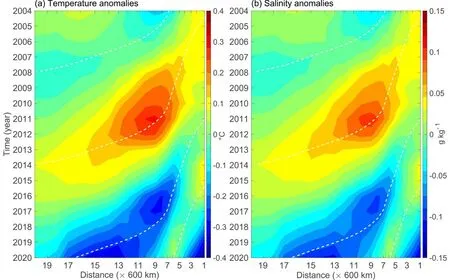
Fig. 7. Time-distance diagram showing temperature (a) and salinity (b) anomalies estimated on the 25 kg m-3 isopycnal surface and along the mean Montgomery stream function isopleths (over 20.8 and 22.7 m2 s-2). The numbers on the horizontal axis correspond to the white dots in Fig. 1a representing the distances along the subduction path from the outcrop line. The white dashed lines indicate the advection path by the mean geostrophic current. The contour intervals are 0.1°C in(a) and 0.05 g kg-1 in (b).
5.3. Possible downstream impacts of spiciness anomalies advected along the pathway
Water masses can be transformed into conditions that have different properties along the subduction pathway. For example, the intensities of spiciness signals vary with time(Fig. 7). The amplitudes of salinity and temperature perturbations increase in the upstream portion of the advection pathway associated with the subduction processes but decrease in the downstream portion associated with obduction processes. The amplitude variations are highly related to horizontal gradients of the isopycnal depth and the mean GV fields, indicating that isopycnal and diapycnal diffusivity effects are important for the transformation of water mass properties within the thermocline layer (Tailleux et al.,2005; Sasaki et al., 2010).
The amplification and attenuation of spiciness anomalies reflect impacts due to the surrounding thermohaline conditions when they are advected along the pathway. Figure 8 shows the anomalies of MLD, the 25 kg m-3isopycnal surface depth, and the thickness along the pathway during the periods 2004-20, and Fig. 9 illustrates the corresponding variations in SST, SSS, and sea surface density (SSD). One main difference among these anomaly evolutions is that the decadal propagating signals are not obvious in the surface layer; SST and SSS anomalies largely exhibit a stationary pattern along the subduction pathway during the periods 2004-20. Furthermore, the spiciness anomalies and their propagations are seen to have relationships with these surface fields, reflecting the impact on the MLD (Fig. 8a) and even SST (Fig. 9a) through the variation in isopycnal surface depth and thickness. It is interesting to note that the MLD perturbation (Fig. 8a) is in-phase with perturbations of SSS (Fig. 9b) and SSD (Fig. 9c) along the pathway but is out-of-phase with SST (Fig. 9a). The variations in the 25 kg m-3isopycnal surface depth and thickness anomalies exhibit out-of-phase relationships in the subduction region but inphase relationships in the downstream region along the pathway. In terms of sea surface anomalies (Fig. 9), it is clearly evident that SST and SSS anomalies tend to be of the opposite signs; thus, their effects on surface density are not compensated by each other, which is contrasted to compensated properties of temperature and salinity perturbations in the thermocline layer as analyzed on the 25 kg m-3isopycnal surface (Fig. 7). As a result, the combined effects of SST and SSS cause SSD anomalies that are enhanced compared with individual effects of temperature or salinity anomaly fields.The SSD-uncompensated effects of SST and SSS anomalies correspondingly lead to large horizontal gradients of density and thus ocean pressure perturbations.
Indeed, there exists a lag relationship between depth/thickness anomalies in the subduction region and SST/MLD anomalies in the tropical region along the pathway (Fig. 8). As mentioned above, when the warm/salty spiciness anomaly arrives in the tropics, a two-year La Niña event occurs coincidently in 2011-12. This may reflect extratropical effects on interannual variability in the tropics,indicating that spiciness anomalies generated in the subduction region can affect the SST after being advected to the tropics sometime later. So, decadal spiciness anomalies and their basin-wide propagations can have negative feedback on SST variability in the tropics through the diapycnal processes. The space-time evolution of spiciness variability and the related processes, mechanisms, and effects analyzed in this paper help shed light on the extratropics-tropics interactions on decadal time scales, which can be important factors attributing to ENSO diversity in the tropical Pacific (Zhi et al., 2015, 2019a).
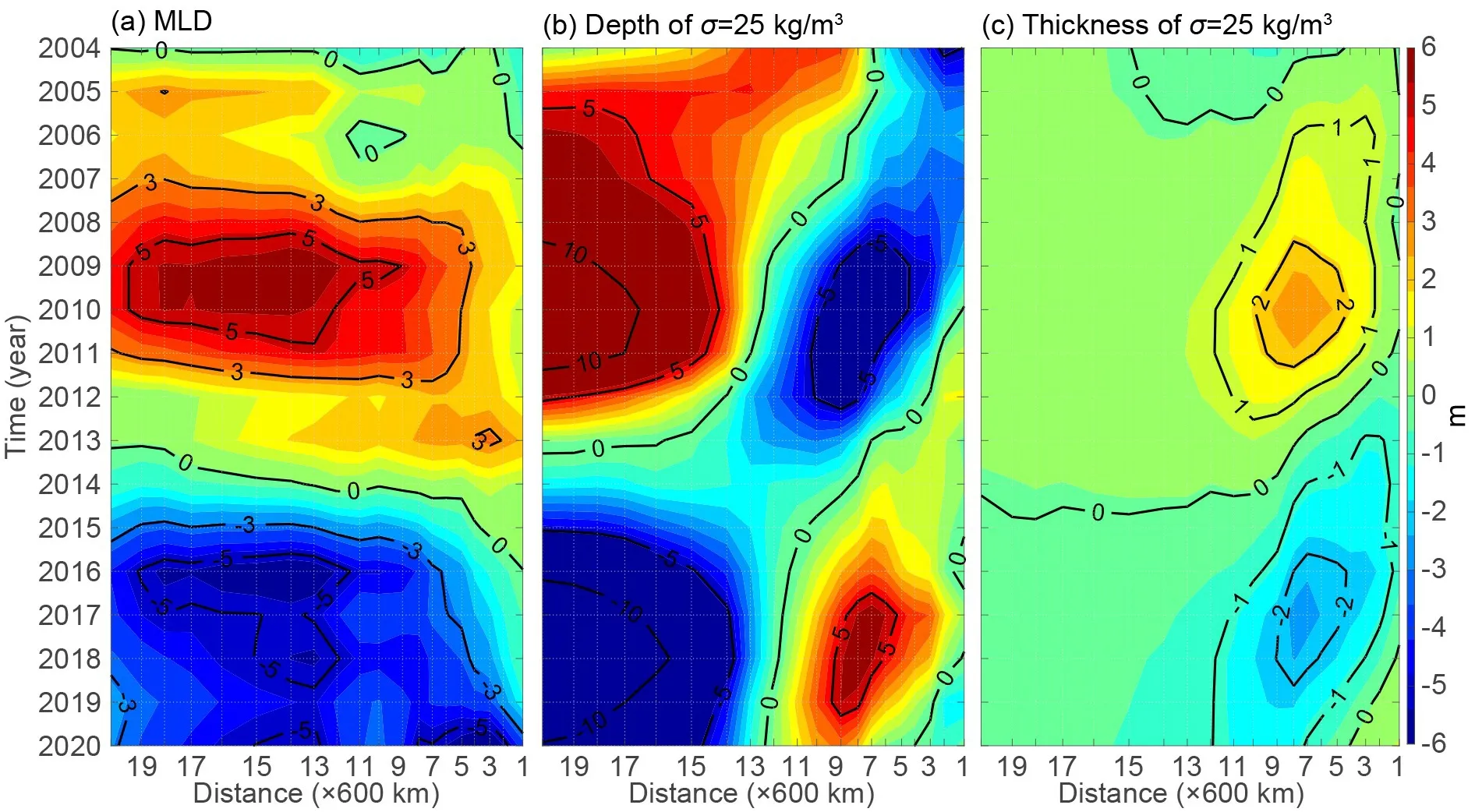
Fig. 8. The same as in Fig. 7 but for anomalies of MLD (a), the 25 kg m-3 isopycnal surface depth (b) and thickness (c)during the periods 2004-20.
Finally, a schematic diagram is presented in Fig. 10 to summarize the spiciness anomaly pathway in the North Pacific, the related processes, and possible downstream effects on local SST in the tropics. The structure and evolution of decadal spiciness anomalies on the isopycnal surface (25 kg m-3) reveal that its formation, advection, and fate around the subtropical gyre provide a clear way for the ocean to communicate between the extratropics and tropics.So, the basin-wide evolution of spiciness anomalies and transitional signatures are clearly traceable in the thermocline layer, being consistent with the advection-dominated subduction pathway. For example, as part of the STCs, the subduction of spiciness anomalies and propagation around the subtropical gyre in the North Pacific provide linkages from the extratropics to the tropics. So, the spiciness variability generated in the mid-latitude can be advected to the tropical Pacific, which can affect tropical climate variability such as ENSO.
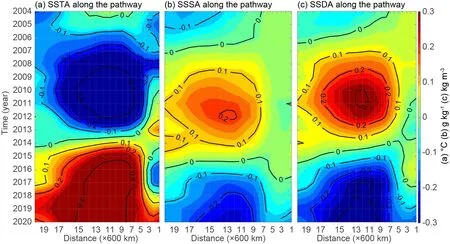
Fig. 9. The same as in Fig. 7 but for anomalies of SST (a), SSS (b), and SSD (c) during the periods 2004-20.
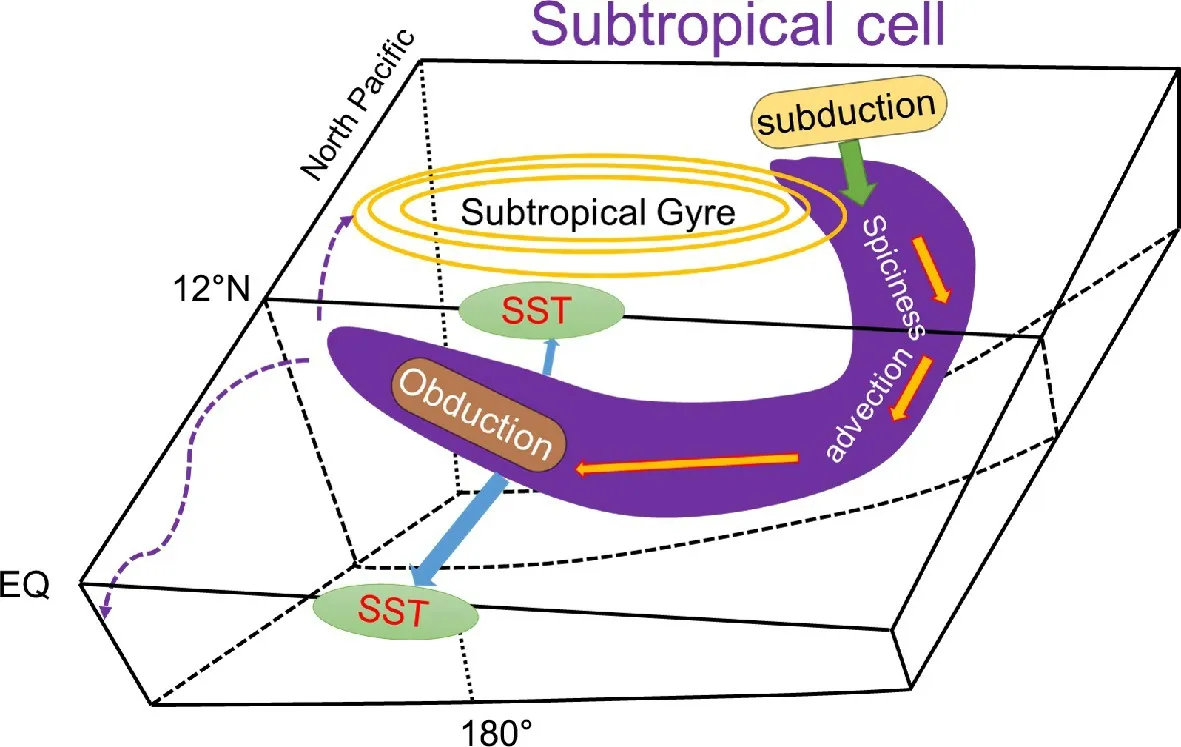
Fig. 10. A schematic diagram illustrating the subducted pathway of spiciness anomalies,which originates from the subtropical northeastern region and circulates around the subtropical gyre towards the western tropics in the North Pacific. When these subducted anomalies arrive in the tropical region, they can have downstream influences on local SST through the obduction processes, as illustrated in the figure.
6. Summary and discussion
Temperature and salinity observations with unprecedented temporal and spatial coverage from Argo allow the identification of decadal spiciness anomalies and their coherent basin-wide evolution. In this study, we document spiciness variability or density-compensated temperature and salinity perturbations in the North Pacific on the isopycnal surfaces over 17-year periods from 2004 to 2020. The isopycnal analyses have been performed to coherently depict the threedimensional patterns of spiciness variability on the 25 kg m-3isopycnal surface. Temperature and salinity variabilities in the thermocline appear to be well organized, with their perturbations being nearly density-compensated along the subduction pathway on decadal time scales. During the analysis period, two spiciness advection events are detected in the North Pacific Ocean. One warm/salty spiciness anomaly is advected clockwise around the subtropical gyre from 2007 to 2013, with obvious signal weakening when it arrives at the western boundary region in 2014-15. The other cold/fresh spiciness anomaly is advected in a similar pathway during 2014-20. The subduction pathway can be adequately determined by the MSF on the isopycnal surface from the outcrop region to the tropical western boundary in the North Pacific through trajectory due to the advection of the yearly spiciness anomalies. During the basinwide transitional evolution, density-compensated properties are consistently conserved along the subduction pathway,indicating a coherent spiciness signature of temperature and salinity variations.
Similar spiciness anomalies are also seen in the South Pacific during the analysis period (Luo et al., 2005; Zhang and Qu, 2014; Zeller et al., 2021). Preliminary results indicate that there exist coherent relationships between decadal spiciness variability in the South and North Pacific. Also, there is an obvious asymmetry in the structure and evolution of spiciness anomalies between the South and North Pacific, and there can exist a combined downstream impact of the advected spiciness anomalies originated from the North and South Pacific. Correspondingly, these asymmetric effects induced by subducted spiciness anomalies in the extratropics can play a role in the diversity of ENSO in the tropics.
Further studies are clearly needed to investigate the downstream impacts of spiciness signals when they propagate into the western tropical Pacific. One related issue is the fate of spiciness anomalies when propagating from the subtropics into the tropics; attenuation in spiciness anomaly amplitude is clearly evident. One important attenuation process is the diffusion effects of temporal current variability on spiciness anomalies along the subduction pathway. For example,part of the spiciness anomaly is seen to overshoot on its way into the shadow zone around 5°-10°N in the eastern Pacific(Figs. 4 and 5). This overshooting through the interior path is consistent with modeling results from Fukumori et al.(2004), evidently reflecting the enhanced tracer transports by the velocity field from the subtropics to the equator.Also, the spiciness anomalies are seen to split into northward and equatorward parts when they propagate into the western boundary where the NEC accordingly bifurcates into the northward Kuroshio and the equatorward Mindanao current, respectively. Thus, the subducted anomalies can be further attenuated by the mixing due to the western boundary current.
The propagation of subducted spiciness anomalies into the tropics can affect surrounding temperature and salinity characteristics, which determine the source water properties for the equatorial upwelling (Fukumori et al., 2004). Along the equator, for example, the spiciness signals are apparent,which is dominated by fluctuations of water properties due to the strong spiciness front. So, the subducted decadal spiciness anomalies in the extratropics may have negative feedback on SST variability in the tropics through the diapycnal process. The space-time evolution of spiciness signals with related processes, mechanisms and effects provide insight into the understanding of ENSO diversity and modulation(Schneider, 2004). Nevertheless, the quantification of the impact of the spiciness anomalies from the extratropics on tropical climate is difficult to make from these observationbased analyses alone.
Our physical understanding of the decadal spiciness variability in the ocean thermocline is still very limited. The origins of spiciness anomalies in the North Pacific need further investigation. A variety of mechanisms are present that can be responsible for the generation, maintenance, and propagation of the coherent spiciness anomalies in the subtropics, including remote processes (e.g., mean advection of STCs and Rossby wave propagation), local processes (e.g.,directly anomalous wind forced signals), and stochastic atmosphere forcing in the mid-latitude that can induce subsurface ocean responses whose perturbations are then advected by the STC in North Pacific. Due to limited data used in this study, we are unable to perform quantitative analyses to separate specific mechanisms responsible for the observed spiciness variability in different regions and attribute their connection to SST anomalies in the tropics. In addition, the 17-year observational record is still too short to assess the statistical significance of the decadal spiciness variations. It is necessary to perform model experiments and theoretical analyses to improve our understanding of spiciness variability and its climatic effects on the tropical ocean-atmosphere interactions. Much more research is needed to improve our understanding of decadal-interdecadal spiciness variability and its effect on the Pacific ocean-atmosphere system.
Acknowledgements.The authors wish to thank the two anonymous reviewers for their comments that helped to improve the original manuscript. This research was supported by the National Natural Science Foundation of China [NSFC; Grant Nos.41690122 (41690120), 42030410], the Strategic Priority Research Program of the Chinese Academy of Sciences (Grant Nos. XDB 40000000, XDB 42000000, and XDA19060102). The RG Argo data set was available online (at http://sio-argo.ucsd.edu/RG_Climatology.html). Argo profiles were distributed by the Ifremer (Institut français de recherche pour l' exploitation de la mer; at ftp://ftp.ifremer.fr/ifremer/argo). The Argo data were collected and made freely available by the International Argo Program and the national programs that contribute to it (http://www.argo.ucsd.edu,http://argo.jcommops.org). The Argo Program is part of the Global Ocean Observing System.
杂志排行
Advances in Atmospheric Sciences的其它文章
- The IAMAS-CNC Early Career Scientists Nobel Prize Online Interpretation Workshop
- Contrasts between the Interannual Variations of Extreme Rainfall over Western and Eastern Sichuan in Mid-summer
- Analysis of the Winter Cloud-to-Ground Lightning Activity and Its Synoptic Background in China during 2010-20
- Quantifying the Spatial Characteristics of the Moisture Transport Affecting Precipitation Seasonality and Recycling Variability in Central Asia
- Strengthened Regulation of the Onset of the South China Sea Summer Monsoon by the Northwest Indian Ocean Warming in the Past Decade
- Distinct Evolution of the SST Anomalies in the Far Eastern Pacific between the 1997/98 and 2015/16 Extreme El Niños
